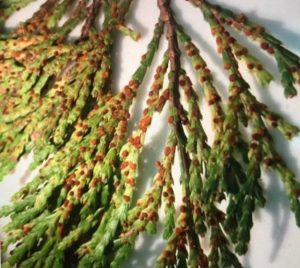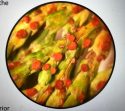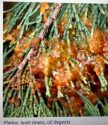If you are seeing bright orange globs of jelly attacking your incense cedar tree, this is likely cedar broom rust, also referred to as Pacific Coast pear rust. Why the two names? Well, this particular disease is unique in that it requires two separate hosts to complete its life cycle. The fungus (Gymnosporangium libocedri) begins its life cycle on incense cedar where, in early spring, the fungus produces spores in jelly-like orange masses during wet weather.
These spores don’t re-infect incense cedars, but are windblown to the alternate host. Pears are often the preferred alternate host, but a variety of trees and shrubs in the rose family, including apple, crabapple, hawthorn, mountain ash, quince and serviceberry are also susceptible. Spores can be blown in the air for up to 6 to 10 miles. On the alternate host, leaf spots will be produced later in the spring. Spores produced on this host are windblown to the incense cedars, where they initiate infections. The jelly-like orange masses will be seen the following spring. Spores, from a single infection, may be produced over a 2 to 3-year period on cedars.
Cedar trees and rosaceous plants with numerous infections can decline and may die. In most wildland and natural settings this disease often requires no control. In landscape settings, the disease can be unsightly and control may be warranted. It is advised to prune out the rust from cedars before spring when they are still dry and before they have released spores. Spores can survive on cedars for three years, while living only for one year on rosaceous plants.
New spores attack rosaceous plants annually. Gardeners can break the fungus cycle by removing rosaceous plants in the vicinity of cedars, or they can spray a fungicide on pears and other rose family plants prior to spore release to break the disease cycle.
Scott Oneto is a University of California Cooperative Extension Farm Advisor for the counties of El Dorado, Amador, Calaveras, and Tuolumne. He can be reached at sroneto@ucanr.edu
UCCE Master Gardeners of Tuolumne County can answer home gardening questions. Call 209-533-5912 or fill out our easy-to-use problem questionnaire. Check out our UCCE Master Gardener website. You can also find us on Facebook.



